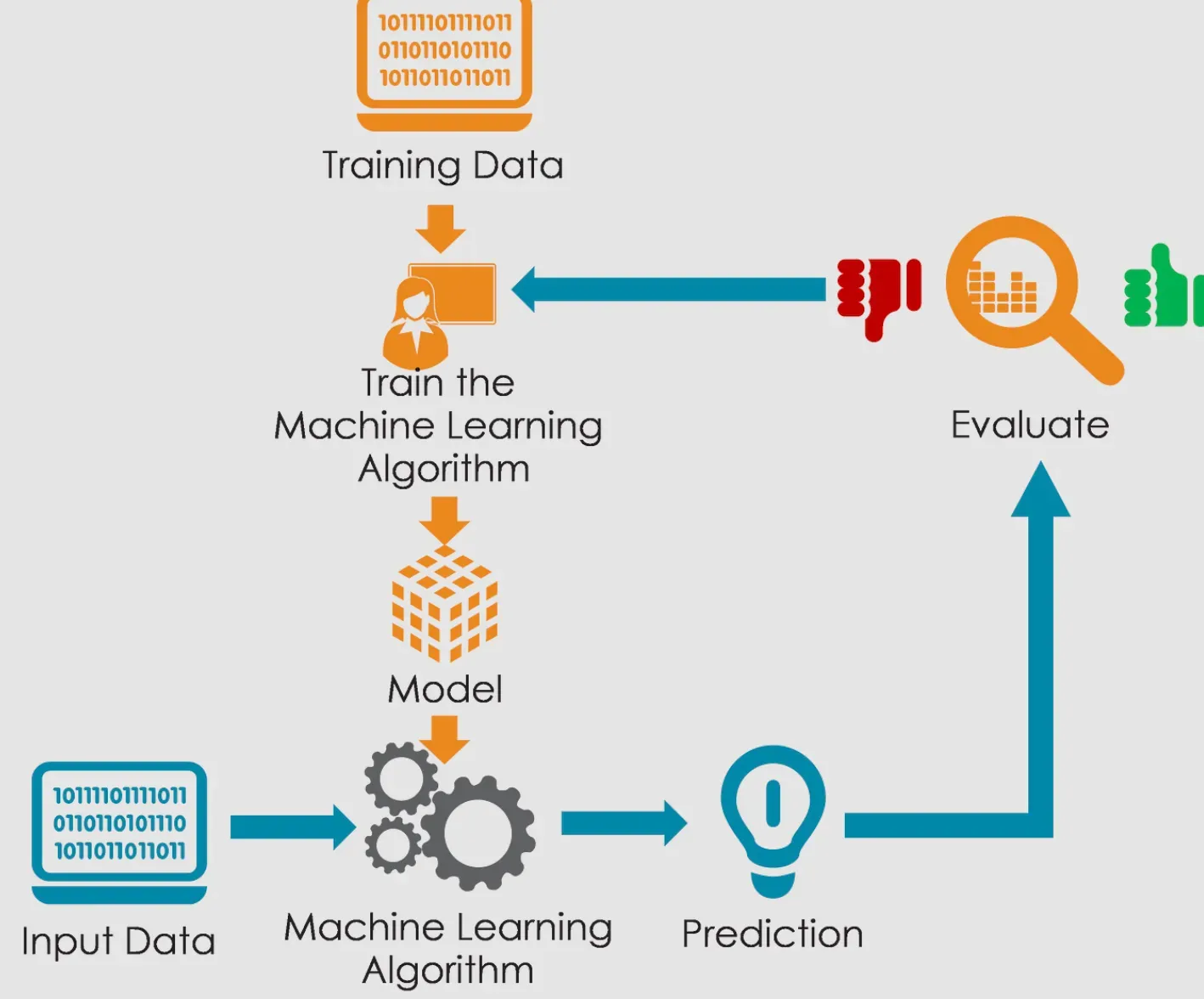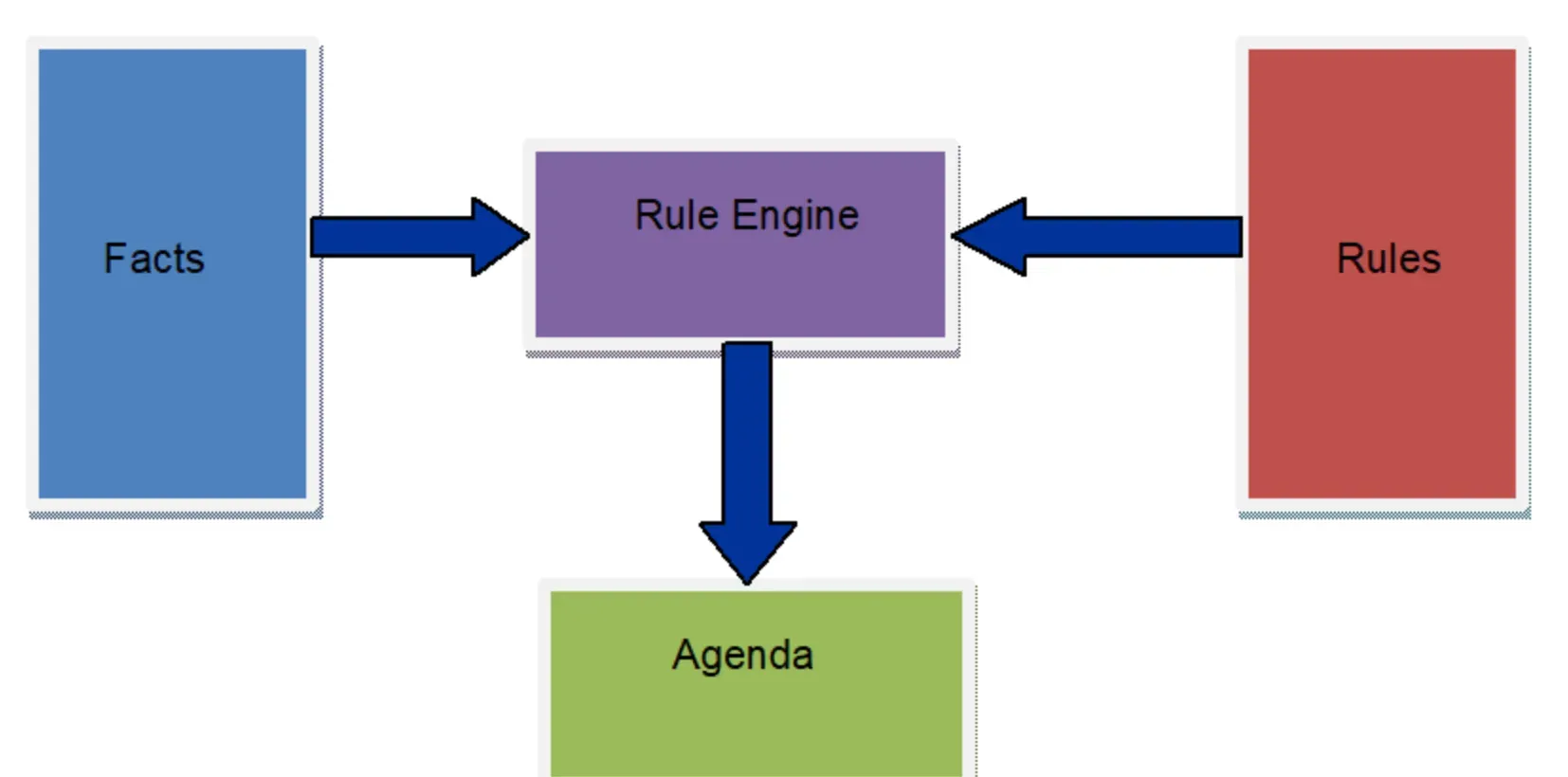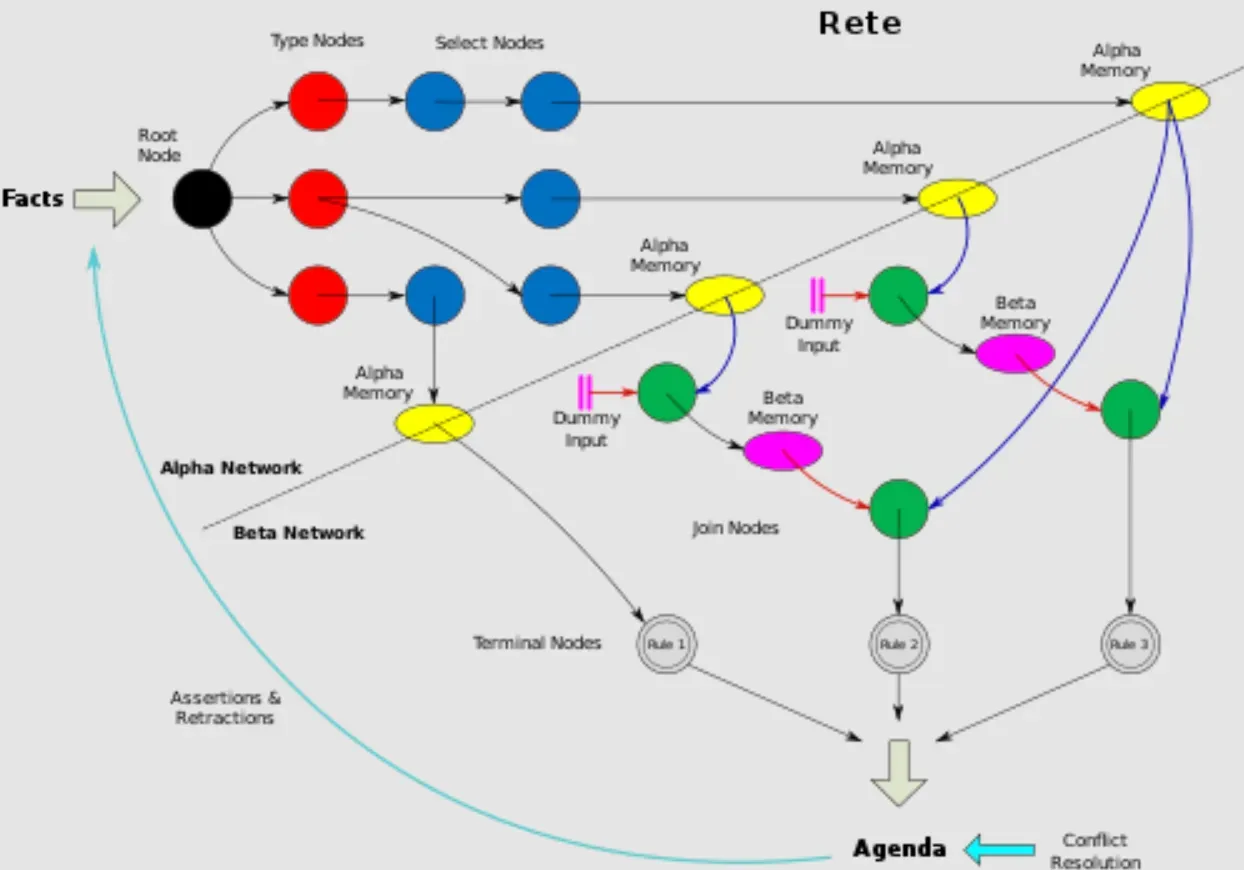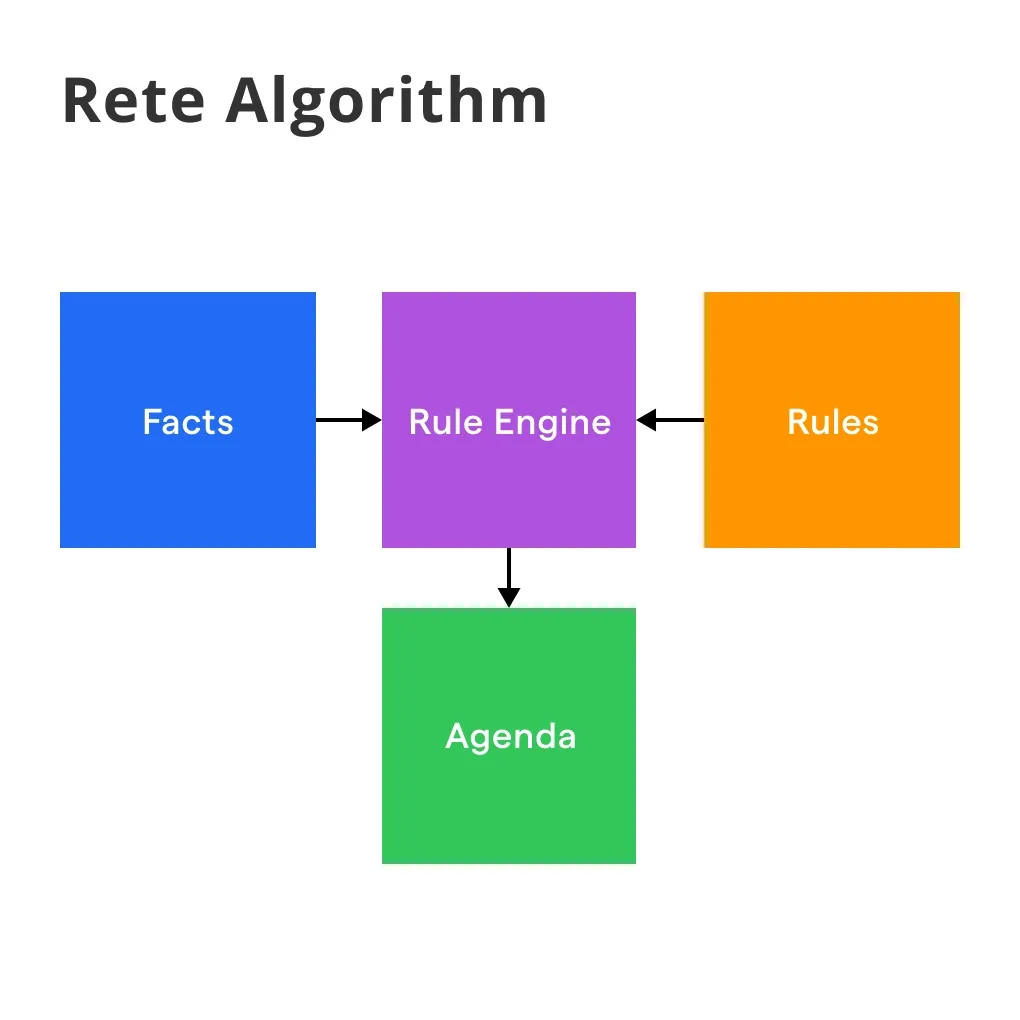What is the Rete Algorithm?
The Rete algorithm is a fascinating piece of computational machinery primarily used for pattern matching in rule-based expert systems.
Named after the Latin word for 'net', Rete, it is known for its efficiency in evaluating rules to identify which actions to execute.
Origin
A brainchild of Dr. Charles Forgy of Carnegie Mellon University, its inception dates back to his PhD thesis in 1974. It was established to address the inefficiency problem in Artificial Intelligence (AI) rule-based systems.
Key Characteristics
Efficiency is the Rete algorithm's hallmark. This algorithm structures rules into a discrimination network (or 'Rete network') allowing instant access to matched rules. It’s also designed to remember previous matches, preventing unnecessary reevaluation and ensuring swift pattern recognition.
Application Areas
The Rete algorithm’s primary application lies in rule-based systems in AI, specifically in expert systems.
However, its use has extended to other domains like complex event processing, production systems, business rules engines, and network intrusion detection systems.
Impact on Artificial Intelligence
In AI, the Rete algorithm revolutionized the development of rule-based expert systems by addressing their inefficiency. Its capacity to minimize reevaluation and quickly access matched rules places it at the heart of many modern AI systems.
Who can Benefit from the Rete Algorithm?
Researchers and developers in AI can benefit enormously from understanding and applying the Rete algorithm.
Its efficiency rewards, especially in rule-based expert systems, can significantly elevate their work, making the Rete algorithm a valuable tool in their arsenal.
Businesses
Companies that use rule-based systems, such as airline reservation systems or recommendation systems in ecommerce, can leverage the benefits of the Rete Algorithm’s swift pattern recognition and reduced reevaluation.
Business Analysts
Business analysts can also benefit from the Rete algorithm when using business rules engines for decision-making. It simplifies the handling of a large number of rules, aiding quick and efficient decision-making.
Education Sector
In the educational sector, the Rete algorithm can be a crucial part of AI-related curriculum, including computer science courses or data science specializations.
When should you use the Rete Algorithm?
If you're dealing with rule-based systems that require efficient pattern matching within a large set of rules, invoking the Rete algorithm can be a game-changer.
Systems with Dynamic Data
Your system often encounters dynamic data, i.e., data that change frequently and need constant reevaluation of rules. The Rete algorithm excels in such environments.
Complex Event Processing
At times, when recognizing patterns and correlating events is of utmost importance - for example, in complex event processing or network intrusion detection - the Rete algorithm serves as a reliable ally.
Consistent Rule Execution
In cases requiring continuous and consistent rule execution, the Rete algorithm is an ideal choice due to its superior handling of iteration over matched rules.
Efficient Reasoning
Finally, in expert systems where reasoning must be both fast and efficient, the Rete algorithm is an indispensable tool in the developer's toolkit.
Where is the Rete Algorithm Used?
Applications that provide solutions by mimicking human expertise, such as systems for medical diagnosis, make excellent use of the Rete algorithm for pattern matching and efficient reasoning.

Business Rule Engines
Reliable and efficient processing of business rules is essential for modern enterprises. The Rete algorithm finds its use in business rules engines to handle large and complex rule sets efficiently.
Complex Event Processing Systems
In complex event processing systems where real-time pattern matching, data analysis, and response are vital, such as stock trading analytics or telecom network management, the Rete algorithm plays a crucial role.
Production Systems
Production systems that demand efficient and consistent iteration over matched rules bear the Rete Algorithm’s influence. Examples include automated production workflows and product recommendation systems.
Intrusion Detection Systems
To safeguard against cyber threats, network intrusion detection systems apply the Rete algorithm for pattern matching, analyzing and correlating network activities to detect any potential threats.
Why Use the Rete Algorithm?
Understanding the unique value proposition of the Rete algorithm.
Increases Efficiency
The Rete algorithm significantly ramps up efficiency by saving match results to prevent their re-evaluation. Its performance advantage shines when facing large rule sets, making the Rete algorithm a preferred tool for handling complex rule-oriented systems.
High Scalability
It is the algorithm's ability to manage large rule sets effectively that makes it highly scalable. It maintains its traits of speed and efficiency even as the rule complexity increases, limiting any serious performance impacts.
Flexibility in Rule Modification
With the Rete algorithm, modifying a rule or adding new rules into the system does not incur a heavy computational cost. It adjusts to alterations in the rule set without repeated computations of the unaltered parts, showcasing flexibility.
Thorough and Consistent Rule Execution
By iterating consistently overmatched rules, the Rete algorithm ensures thorough execution. This consistent handling is critical in systems like automated workflows or recommendation engines, where rules need to be executed repeatedly.
Facilitates Complex Event Analysis
Last but not least, the Rete algorithm is a significant enabler of complex event analysis. Its capability to recognize patterns and correlating events in real time makes it vital in many high-stakes scenarios like network intrusion detection or real-time analytics.
Challenges in Using the Rete Algorithm
While it holds numerous advantages, the Rete Algorithm is not without its challenges.

Memory Consumption
With the Rete algorithm storing match results to avoid reevaluation, memory consumption can increase considerably. It's a trade-off between computational efficiency and memory space, particularly for larger rule sets.
Complexity of the Rete Network
As the rule set grows in size or complexity, so does the corresponding Rete network. Maintaining such a growing network can be challenging, adding layers of complexity to the computational process.
Data Dependency
The Rete algorithm’s efficiency is highly dependent on the nature of the data it processes. Constant changes in the data pattern can affect its performance, making the algorithm a less efficient choice in certain scenarios.
Optimal Use Condition
While it is a champion in solving complex rule-based problems, the Rete algorithm may not always be the best choice. It works optimally when handling large rule sets where data frequently changes - under different conditions, other algorithms might prove more effective.
Difficulty in Understanding and Implementing
The Rete algorithm is quite advanced and can be difficult to understand and implement, particularly for newcomers to the field. Its inherent complexity often requires a solid understanding of rule-based systems and pattern matching.
Best Practices When Using Rete Algorithm
Best practices help achieve optimal results when using the Rete algorithm.
Ensure Clean Data Input
Feeding high-quality, accurately formatted data can significantly enhance the Rete algorithm's performance.
Handle Memory Usage Smartly
Having a good memory management strategy can help balance the trade-off between efficiency and memory consumption. This could include assigning a dedicated memory space or adopting techniques to free up or reuse memory.
Keep Updating Knowledge about the Rete Algorithm
Continuous learning about the Rete Algorithm can enhance its application quality, especially as advancements are made or new use cases emerge.
Balance Rule Complexity
Ensuring that the complexity of the rules matches the complexity of the tasks can boost both efficiency and scalability.
Approach Experts for Initial Implementation
Given the algorithm's complexity, seeking the guidance of experts during initial implementation can be beneficial, saving time and reducing the risk of errors.
The Future: Trends and the Rete Algorithm
Lastly, let's talk about the Rete algorithm’s interaction with current technological trends.

Integration with Other Algorithms
The integration of the Rete algorithm with other algorithms in various projects is an emerging trend. This melding of technologies could offer superior solutions in domains like Artificial Intelligence, machine learning, and real-time analytics.
Application in Cybersecurity
The increasing integration of the Rete algorithm in cybersecurity is a noteworthy trend. For instance, greatly enhanced intrusion detection systems are being developed with robust pattern recognition capacities.
Enhanced Business Rule Engines
In the realm of business rules engines, the Rete algorithm is expected to see increased usage in handling complex rule sets more efficiently and effectively.
Dynamic Optimization Techniques
In time, the Rete algorithm could see the development of dynamic optimization techniques, refining its scalability, and efficiency. These advancements may make the Rete algorithm an even more powerful tool.
Improving Accessibility
Making the Rete algorithm more accessible by simplifying its understanding and implementation is an expected trend. This would broaden its use and widen the range of applications that could harness its capabilities.
Frequently Asked Questions (FAQs)
What is the primary purpose of the Rete Algorithm?
The Rete algorithm, used in rule-based systems, accelerates execution by memorizing intermediate results of rule-pattern tests, reducing repetitive evaluations for recurring patterns.
How does the Rete Algorithm handle rule matching?
The Rete algorithm builds a data structure, known as a Rete network, representing all rule conditions. It efficiently matches these conditions with data facts, identifying applicable rules for a given situation.
What role does the Rete Algorithm play in artificial intelligence?
Rete algorithm is widely utilized in Production Rule Systems, a type of AI system, where it executes rules efficiently in the face of changing and complex datasets.
Can the Rete Algorithm manage a large number of rules?
Yes, the Rete algorithm is particularly suitable for scenarios with a large number of rules as it efficiently identifies and applies changes without checking each rule individually.
Is there any drawback to using the Rete Algorithm?
The primary drawback of the Rete algorithm is its potential for high memory consumption, due to storing intermediate results. Consequently, it may not be ideal for memory-constrained environments.


